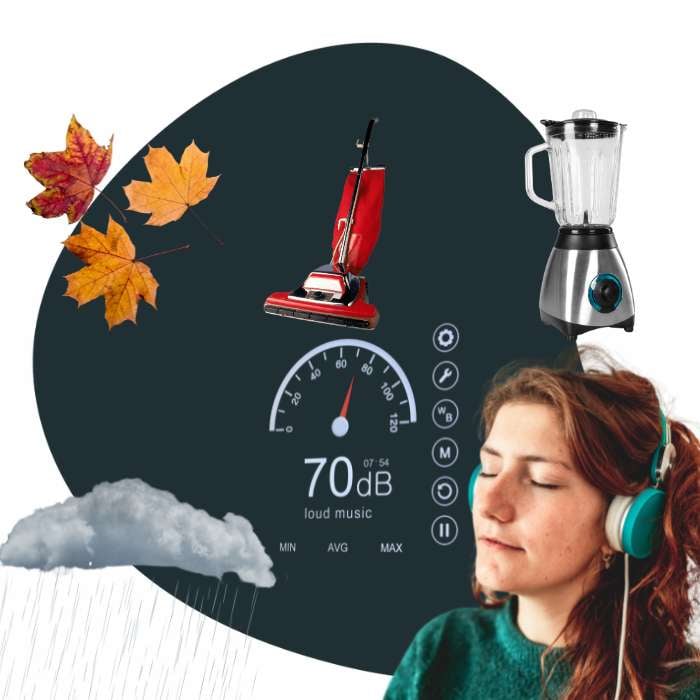Key Takeaways:
- Sound is measured in decibels (a logarithmic scale), which measures the intensity of sound and ranges from barely audible to the threshold of pain.
- Decibel phone apps are an easy (and free) way to check your environmental sound exposure.
- Monitoring sound exposure and limiting time to sound at or above 85 decibels (dB) reduces risk of noise-induced hearing loss and tinnitus.
- Wearing hearing protection is another effective way to reduce noise exposure.
.png)
As an audiologist, I have worked with patients who experience hearing loss due to various reasons, including exposure to high decibel (dB) levels of sound. At the same time, I work with people who are looking to protect their hearing and prevent future damage.
It's a common misconception that only loud sounds can harm our hearing, but even moderate noise levels can be detrimental over time. In this article, we'll explore the basics of decibel levels, what sounds fall at different decibel levels, and the impact of sound on our hearing health.
What is a decibel?
The decibel is a unit of measurement used to determine the intensity of sound. Essentially, it measures how loud a sound is perceived by our ears. It can be tricky to understand because it's not a linear scale- a sound at 100 dB is not twice as loud as a sound at 50 dB but rather sounds about 30 times as loud. So with that being said, you might be wondering how loud a particular decibel level is.
Here are some common sounds and their corresponding decibel levels:
- 0 dB: The threshold of hearing, or the barely perceptible sound of a quiet room.
- 10 dB: sounds of normal breathing
- 20 dB: rustling leaves
- 30 dB: soft whisper
- 40 dB: light rain
- 50 dB: quiet office
- 60 dB: normal conversation
- 70 dB: vacuum cleaner
- 80 dB: a blender
- 90 dB: a hairdryer
- 100 dB: a motorcycle
- 110 dB: a rock concert
- 120 dB: a jet plane takeoff
- 130 dB: a jackhammer
- 140 dB: The threshold of pain or damage to hearing, such as a gunshot or fireworks.
It's important to note that even sounds that fall within the "safe" range of decibel levels can become harmful if we are exposed to them for extended periods. The National Institute on Deafness and Other Communication Disorders suggests the following guidelines for safe listening:
- 85 dB: Limit exposure to no more than 8 hours.
- 88 dB: Limit exposure to no more than 4 hours.
- 91 dB: Limit exposure to no more than 2 hours.
- 94 dB: Limit exposure to no more than 1 hour.
- 100 dB or more: Limit exposure to no more than 15 minutes.
It's crucial to understand and be aware of the sounds around us and to take steps to protect our hearing whenever possible. This can include using earplugs or headphones with noise-cancellation features, taking breaks from loud environments or sounds, and lowering the volume on personal listening devices. Consistent use of these strategies can help prevent long-term hearing damage.
Strategies to Prevent Hearing Loss
In our daily life, we often find ourselves in environments that expose us to potentially harmful noise. These situations are not always avoidable, but the impact of high decibel levels on our hearing can be mitigated. The key lies in understanding and implementing effective strategies to prevent noise-induced hearing loss. From wearing protective gear to controlling the volume of our personal devices, there are several practical steps we can take to preserve our hearing health amidst a noisy world. Let's delve deeper into these strategies and understand how they can protect us from the risks of noise pollution.
It Starts With Awareness
Being mindful of the noise level in your surroundings is a significant first step towards sound hygiene. One practical tool to help recognize potential threats to your hearing health is a decibel meter app. Easily available for smartphones, these apps provide real-time readings of the ambient noise level around you, helping identify when the sound becomes dangerously loud.
Use Hearing Protection
If you find that your environment frequently exceeds safe decibel levels, consider implementing precautionary measures such as using earplugs, or if possible, modify your surroundings to reduce the noise. Remember, the key to preserving your hearing health lies in consistent and proactive steps to mitigate the impact of loud noise.
The Impact of Loud Headphone Volume
Excessive headphone volume is a serious, but often overlooked contributor to noise-induced hearing damage. When we listen to music or other audio content at high volumes through headphones, we are essentially pumping sound directly into our ears. This direct exposure significantly intensifies the impact of noise, often leading to damage of the delicate inner ear structures responsible for transmitting sound to the brain.
According to the World Health Organization, exposure to noise levels above 85 dB for extended periods can potentially cause hearing loss. Considering that many personal audio devices can produce sound levels well above 100 dB, it's easy to imagine how misuse of headphones can lead to hearing damage. The risk increases with prolonged exposure, making it especially dangerous for those who use headphones for several hours a day.
When using headphones, it's important to follow the 60/60 rule – listen to audio content at no more than 60% of the maximum volume for no more than 60 minutes at a stretch. Also, consider using noise-canceling headphones. They reduce the need to increase volume to overcome background noise, providing a safer listening experience. As always, awareness and moderation are key to maintaining your hearing health.
Limit Time Exposure to Loud Settings
Another important strategy to prevent hearing loss is to limit the amount of time spent in noisy environments. Extended exposure to loud sounds can overwork the hair cells in our ears, leading to permanent damage. If you find yourself in a situation where loud noise is unavoidable and protective measures like earplugs are not within reach, the best thing you can do is limit your exposure time.
Try to take regular breaks from the noisy environment, giving your ears time to recover. For example, if you're at a concert or club, step outside or move to a quieter area every so often. Avoid standing near speakers or other sources of loud sounds. Remember, the closer you are to the source of the noise, the more damaging it can be.
If you work in a noisy occupation, such as construction or aviation, follow the occupational safety guidelines for noise exposure. This usually involves wearing protective gear and taking periods of rest in quieter settings. Always adhere to the guidelines laid out by occupational health and safety authorities, as they are designed to protect you from noise-induced hearing loss.
Looking for more resources?
Read about decibel level apps here.
Read about how to prevent hearing loss from headphones here.
Read about noise induced hearing loss here.
Final Thoughts
In conclusion, noise-induced hearing loss is a substantial public health concern that often goes unnoticed until it's too late. The modern world is filled with potential sources of damaging noise, but by understanding the risks and implementing effective preventative strategies, we can significantly reduce our exposure.
Crucial steps include being aware of the noise levels in our environments, utilizing hearing protection when necessary, moderating the volume and duration of headphone usage, and limiting time in loud settings. By taking these precautions, we can preserve our hearing health and enjoy the sounds of life safely and comfortably. Remember, hearing once lost, is lost forever. So, it's never too early to start taking care of your hearing health.






